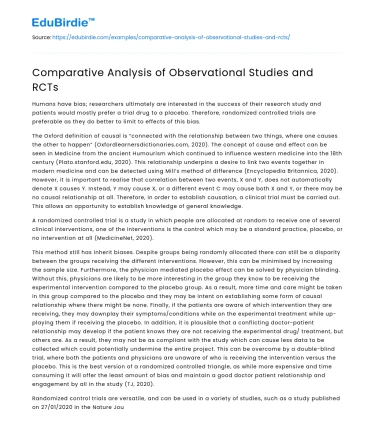Humans have bias; researchers ultimately are interested in the success of their research study and patients would mostly prefer a trial drug to a placebo. Therefore, randomized controlled trials are preferable as they do better to limit to effects of this bias.
The Oxford definition of causal is “connected with the relationship between two things, where one causes the other to happen” (Oxfordlearnersdictionaries.com, 2020). The concept of cause and effect can be seen in Medicine from the ancient Humourism which continued to influence western medicine into the 18th century (Plato.stanford.edu, 2020). This relationship underpins a desire to link two events together in modern medicine and can be detected using Mill’s method of difference (Encyclopedia Britannica, 2020). However, it is important to realise that correlation between two events, X and Y, does not automatically denote X causes Y. Instead, Y may cause X, or a different event C may cause both X and Y, or there may be no causal relationship at all. Therefore, in order to establish causation, a clinical trial must be carried out. This allows an opportunity to establish knowledge of general knowledge.
Save your time!
We can take care of your essay
- Proper editing and formatting
- Free revision, title page, and bibliography
- Flexible prices and money-back guarantee
A randomized controlled trial is a study in which people are allocated at random to receive one of several clinical interventions, one of the interventions is the control which may be a standard practice, placebo, or no intervention at all (MedicineNet, 2020).
This method still has inherit biases. Despite groups being randomly allocated there can still be a disparity between the groups receiving the different interventions. However, this can be minimised by increasing the sample size. Furthermore, the physician mediated placebo effect can be solved by physician blinding. Without this, physicians are likely to be more interesting in the group they know to be receiving the experimental intervention compared to the placebo group. As a result, more time and care might be taken in this group compared to the placebo and they may be intent on establishing some form of causal relationship where there might be none. Finally, if the patients are aware of which intervention they are receiving, they may downplay their symptoms/conditions while on the experimental treatment while up-playing them if receiving the placebo. In addition, it is plausible that a conflicting doctor-patient relationship may develop if the patient knows they are not receiving the experimental drug/ treatment, but others are. As a result, they may not be as compliant with the study which can cause less data to be collected which could potentially undermine the entire project. This can be overcome by a double-blind trial, where both the patients and physicians are unaware of who is receiving the intervention versus the placebo. This is the best version of a randomized controlled triangle, as while more expensive and time consuming it will offer the least amount of bias and maintain a good doctor patient relationship and engagement by all in the study (TJ, 2020).
Randomized control trials are versatile, and can be used in a variety of studies, such as a study published on 27/01/2020 in the Nature Journal where the effects of Ai Chi compared to conventional water aerobics was studied for improving balance in stroke patients (Ku et al., 2020).
In comparison, an observational study is when researchers observe the effect of a risk factor, diagnostic test, treatment or other intervention without trying to change who is or isn’t exposed to it. These comprise largely up of two types, cohort and case studies (Iwh.on.ca, 2020). Case-control studies are respective, and they look at 2 groups, one with the disease and the other without, and look back to see whether there is a statistically significant difference in the rate of exposure to a defined risk factor between the groups. Cohort studies can be retrospective but are more commonly prospective. They follow a group of people for a defined period to assess the proportion that develop the disease/ outcome of interest (Students 4 Best Evidence, 2020). Observational studies are likely to have more bias in them randomised controlled trials, as researchers are aware of which groups/ people are exposed to the potential risk and therefore, there is likely to be an effort to force a correlation to suggest causality. However, they are still useful and used today, for example, published in the BMJ heart journal on 18/04/16 was an analysis of previous longitudinal observational studies was carried out to explore if loneliness and isolation were risk factors for stroke and coronary heart disease. (Valtorta et al., 2016)
Observation studies do have advantages over randomised controlled trails. Firstly, they are cheaper to conduct, faster (as they require less planning), and can have comparable to randomised controlled trials when well planned. It is also important to mention that observational studies often mimic real life/real clinical practise as they are less ridged when it comes to inclusion of patients than randomized controlled trials. Interestingly, observational studies can be carried out alongside randomized controlled trials to confirm their findings (Mariani and Pêgo-Fernandes, 2020). However, in some circumstances due to ethics and practicality they are the best option to conduct research; for example, the effect of smoking on health. It would be unethical to force a group to smoke, especially if they do not already smoke, to study the health effects particularly as we know that it is harmful. Overall, observational studies are still important in research, and despite their biases are sometimes ethically necessary.
In conclusion, studies can be used to establish whether there is a causal relationship, with each type of study having different positives and negatives, and are appropriate to different types of studies, although they can be used in tandem.






 Stuck on your essay?
Stuck on your essay?

